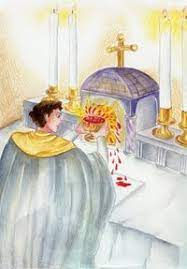The Catholic Defender: St. Marcellinus and Peter
- Donald Hartley

- Apr 23, 2021
- 3 min read
Updated: Apr 24, 2021

Today, Deepertruth is looking back to a time when the civilized world was not so civilized. The Roman world was ruled by a terrible tyrant (Diocletian 303) who began a tenth major persecution of Christians within the Roman Empire.
While I was stationed in Germany, I was graced to travel in pilgrimage to many sites and places where the Church would eventually convert the barbarian.
I have been in a second century catacomb built in the side of a mountain hollowed into rock.
You can still see the Altar where the early Christians there attended Mass hiding from the Romans. Eventually, the priest would be martyred there and his grave has been preserved to mark the early Christian struggle.
St. Marcellinus was a Catholic Priest and Peter, an exorcist, had been captured and placed in a prison where they bore great witness much like St. Paul and Silas (Acts 16:25-40).
The two holy men of God, both of Roman birth, viewed their imprisonment as a means to evangelize and like St. Paul, managed to convert their jailer and his family (Artemius and his wife Secunda).
Artemius would eventually be martyred through beheading while his wife, Secunda and daughter, Paulina, were buried alive under a pile of stones.
According to Pope Damasus, the local magistrate, Severus (served under the Roman Emperor Diocletion) was so enraged at these two men of God because of their many conversions in prison, took them out to a secluded place where they were eventually beheaded.
Severus was trying to prevent a known practice by the Christians that buried their dead and created and honored their relics by making shrines at these sites where candles were used as visible prayer offerings. After having St. Marcellinus and Peter clear the brush and brambles about three miles from Rome, they were executed.

There are a couple of instances that took place that thwarted the magistrates goal, two women, Lucilla and Firmina, by divine assistance, found the bodies ensuring Marcellinus and Peter were properly buried. They were taken near the grave site of St. Tiburtius on the Via Labicana. This location subsequently became known as the "Catacombs of Marcellinus and Peter".
The second thing to note is that the executioner (Dorotheus), himself became a believer through Pope Julius l (337-352 A.D.). It was through the report of the executioner at a great age, given to Pope Damasus (366-384 A.D.) personally, that this story first became known throughout the whole Church.
Soon, reports of miracles of healing and divine interventions were taking place. Finally, in 313 when Constantine became Emperor, his Edict of Milan gave Christians freedom and he honored St. Marcellinus and Peter building a basilica over the site where they were buried.
St. Helena, Constantine's Mother would be buried in a tomb placed in this basilica.
Relics of St. Marcellinus and Peter were sent to Germany in the 9th Century sent by Pope Gregory IV (827-844) to Charlemagne which were to pray for the Conversion of the Germanic peoples.
Today, St. Marcellinus and Peter are mentioned in our Eucharistic Prayer l and are included among the saints in the Roman Canon. Along with St. Paul and Silas, they are part of that great cloud of witnesses that surrounds us with their prayer for us, the Church Militant (Hebrews 12:1, Revelation 5:8).
Like many saints who suffer martyrdom, they are represented often times as men in middle age, with tonsures (a part of a monk's or priest's head left bare on top by shaving off the hair) and palms of martyrdom. Often angels are seen holding a crown each (Revelation 2:10).
St. Marcellinus and Peter's were martyred in 304 and their feast day is June 2.





















Comments